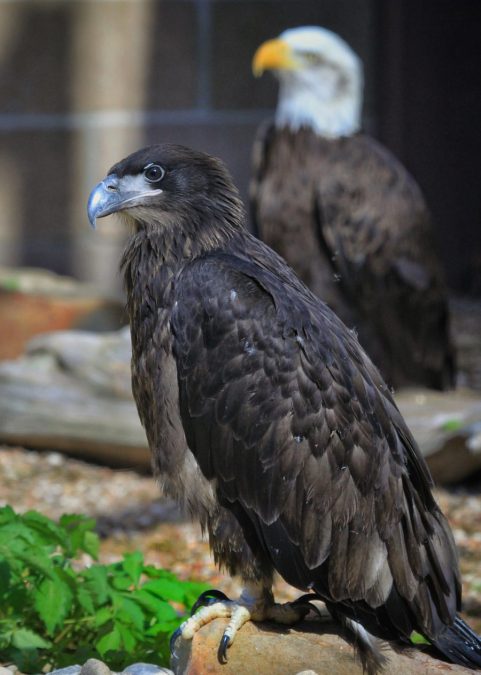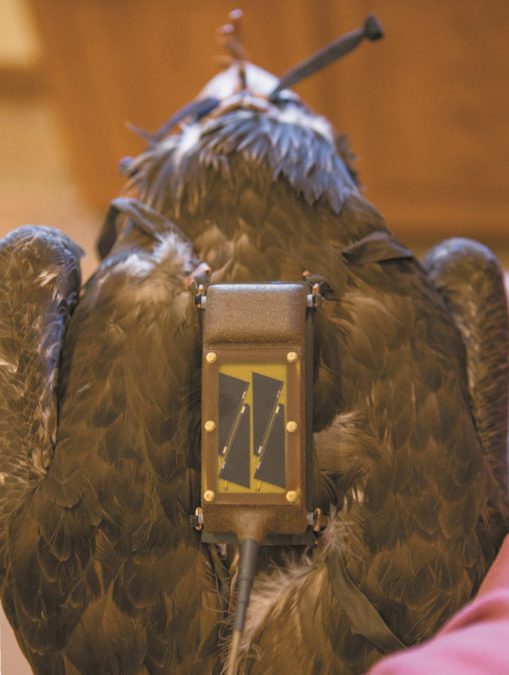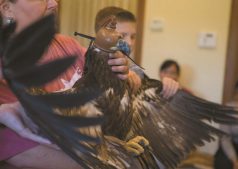
A juvenile bald eagle, hatched at the Citizen Potawatomi Nation Eagle Aviary March 21, was released Sept. 20. The release marks the second time that CPN; U.S. Fish and Wildlife Service; the Raptor View Research Institute in Missoula, Montana; and Sia, the Comanche Nation Ethno-Ornithological Initiative partnered to release and track a juvenile bald eagle. However, the occasion marks the first time that an eagle was hatched at and released from a tribal facility.
Love nest
Although it’s unusual for birds in captivity to show interest in nest building, Kyla and Charlie began to do so shortly after they were introduced to each other. Kyla laid her first eggs in 2015 but broke them due to her inexperience. In 2016 she laid again, but the eggs were not fertile.
“Kyla initially showed some interest in nest building and started pulling twigs and branches and things off the greenery in the enclosure,” said Aviary staff member Bree Dunham. “We provided nest material for them, and she went through the process, but didn’t really have a good idea what she was doing.”
Charlie was an adult when Kyla came to the aviary, so choosing a new partner was also unusual for him. However, he showed interest in Kyla from the moment she entered the enclosure.
“It’s really important for us to give them the quality of life in captivity,” said Aviary Manager Jennifer Randell. “Charlie was one of our original first eagles. When we introduced Kyla a few months later, it was love at first sight. Charlie began following her around watching her bathe, watching her eat. And she’s about three times his body weight. So we didn’t really know if it is going to work out or not because Kyla didn’t really understand since she was a juvenile when we first received her.”
Working through challenges
The aviary has had a relationship with U.S. Fish and Wildlife since its inception, operating under a Native Religious Use Permit. Less than a dozen of these permits are issued in the United States, and CPN is the only facility that has released a juvenile bald eagle hatched at its facility and the first to do so with telemetry to monitor the eagle. Each time the staff encounters something new, a consultation with U.S. Fish and Wildlife is required. Because each tribe operates differently than other facilities, and eagles and other animals have different meanings to each tribe, the process for the consultation is often lengthy.
“U.S. Fish and Wildlife is very supportive,” said Dunham. “We operate under the Native Religious Use Permit. When they designed that permit, they had really good intentions, but I don’t think they understood the scope of what they were talking about. Each tribe is so different. What we believe is culturally important to us may not be the same for another tribe, so all tribes wouldn’t necessarily want to release an eagle.”
The aviary opened June 2012 and was partially funded with a U.S. Fish and Wildlife Service Tribal Wildlife Incentive Grant. The facility now houses 14 eagles and continues to advance its education and outreach through aviary programs.
“This responsibility that the tribe has taken on is multigenerational,” CPN Tribal Chairman John “Rocky” Barrett told the Hownikan. “We plan to meet that responsibility by passing legislation that ensures this facility remains adequately funded and staffed. Our tribal legislation needs to detail how the program is funded and what training is required of the employees. This is our governmental responsibility, not the federal government. We are sovereigns and we have a responsibility as sovereigns to behave as a sovereign government. We must develop legislation that prescribes how this is done since we were the pioneers in developing these methods.”
Building on success
Kyla and Charlie had a little practice being parents before this eaglet we would come to know as Mko Kno hatched. After unsuccessful attempts at hatching eggs of their own, aviary staff partnered with Sia: The Comanche Nation Ethno-Ornithological Initiative to make them parents. It was the first time on record that bald eagles have raised a tawny eagle chick.
“Luckily, here in the state of Oklahoma, we have three Native American aviaries and every aviary is unique in what its focus is,” said Randell. “The focus of Sia is captive propagation, so they have their permit to let their eagles breed and they have exotic eagles. We were able to get a foster chick from them after Kyla and Charlie were unsuccessful in having an eagle of their own.”
The tribe marked another first when it became the first Native American tribe to use a GPS device to track a rehabilitated eagle. Wadasé Zhabwé, one of the first eight eagles to call CPN Eagle Aviary home, was released in April 2013. Rob Domenech from the Raptor View Research Institute equipped the eagle with a GPS device and her travel and hunting progress has been monitored for more than four years. Wadasé regularly returns to the aviary and has flown several thousand miles since her release.
Domenech also helped equip Mko Kno with a similar device. Due to the risk involved, the aviary staff consulted Domenech because of his experience in putting telemetry devices on eagles in the wild.
“Every time you put a transmitter on a young eagle there’s a 70 percent mortality rate,” Domenech said. “That first year of life for any young eagle is difficult.”
Domenech said the tracking and growth of Wadasé has been remarkable, calling it an amazing success story.
Bill Voelker from Comanche Nation Sia also helped with the release. Voelker began operating Sia in the 1970s under a special use permit, before there was a tribal aviary permit. The Sia facility is now home to more than 140 eagles and its staff specializes in propagation and education. Aviary staff trained at the Comanche facility before helping open the CPN aviary.
“The tribal aviary permit allows each tribal entity to do their own thing and establish themselves in a unique way,” Voelker said. “We’ve trained many people and have established a foundation for a cultural protocol that we’re greatly honored to be able to share with people like Jennifer and Bree, but the Citizen Potawatomi Nation has established its own position.”

Longest flight of its life
A telemetry device similar to what was used for Wadasé was placed on Mko Kno before he was returned to the enclosure where he’d spent his entire life. The enclosure was modified so the young eagle could come and go as he pleased, a process called hacking, which is more natural. Although staff thought he might take quite some time to get accustomed to his new surroundings, he took off almost immediately.
Memorial donations in honor of tribal member Stan Brown, who requested that, in lieu of flowers, memorial donations be made to the aviary in his name, helped to fund the telemetry device.
“Once we set the bird on the ground, we expected it to walk about and accustom itself to the equipment,” Chairman Barrett added. “Instead, the moment he was put back in the enclosure he flew off without even taking a step. He flew straight out the hole at the end of the enclosure and off into the trees and within a matter of seconds took longer flights than it had taken in its entire life without any hesitation.”
After Wadasé was released, it took her approximately 23 days to return to the aviary. Within three weeks of his release, Mko Kno had already flown as far north as Nebraska. The aviary staff can retrieve telemetry data every three days and noticed he’s been in great habitats near rivers and large bodies of water, a hopeful sign that the young eagle is finding food for itself.

At the time of his release, Mko Kno weighed about seven pounds and had a wingspan of almost 6 1/2 feet.
“Males were much smaller, so a normal male wingspan is about six feet, making him substantially bigger than usual,” Jennifer Randell said. “We think that’s good because it gives him a better opportunity out there in the wild. Before his release, we measured the wings and weight to make sure he’s healthy and of the right weight to fly. We also checked his feet and beak, so we knew we’re not releasing him with any sort of struggles or handicaps.”
Healing
For aviary staff, the release of this eagle signifies healing for Kyla and Charlie and the Potawatomi people. Charlie, whose Potawatomi name is Zagéndem-nené (Nervous Man), and Kyla, whose Potawatomi name is Kche-Gizhek (Big Sky) both had more serious injuries and were kept in a smaller enclosure with eagles who had less ability to fly. When U.S. Fish and Wildlife confiscated Kyla from an individual with no permit, she had been held in a large kennel for an extended period. She wore the feathers off a portion of her wings and had calluses from turning around in the kennel. Jennifer and Bree trained with Charlie at the Comanche aviary and chose to relocate Charlie to the aviary when it opened. Charlie had injuries to his wing consistent with being struck by an automobile.
“Kyla has come full circle,” Breed Dunham said. “To have an injured bird, who didn’t even really understand how to eat whole food, lay an egg and raise her own chick, it has been that healing process for her.”
The eagle release also has spiritual meaning for Citizen Potawatomi. The Potawatomi Eagle Story explains that Eagle saw that the Potawatomi were still living in the right way and reported that back to the Creator, saving them. As such, many Potawatomi believe that Eagle helps deliver our prayers to the Creator.
“The eagle delivers a message to the creator that people on this earth are still doing the right thing, so the sun comes up and the earth lives another day,” Chairman Barrett explained. “Releasing this eagle goes a long way toward fulfilling that.”
The young eagle was named to reflect this healing and represent the time of year it was hatched. Mko, which means bear in Potawatomi, was chosen because the eagle was hatched during the bear moon. The bear clan was also known as the healing clan for the Potawatomi.
“It really means a lot for Kyla, his mother,” Jennifer Randell added. “I think he was healing for her and she came from a really bad place. To see her come from not even knowing she was an eagle to having a young eagle that we can let go in the wild is fantastic. That’s coming full circle for her.”
Check cpn.news/eaglevisions frequently for updates about Mko Kno, Wadasé, and the other eagles at the aviary.
